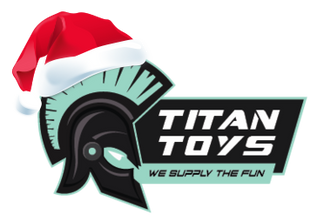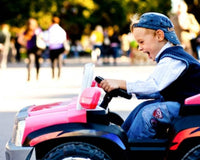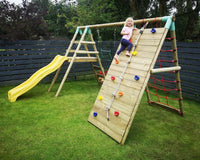Imagine spending the weekends travelling the world to watch Formula 1. Watch the fast cars, engineered to perfection for the ultimate speed, and feel the sound go through your body as they flash past. How exciting would it be if your son or daughter were in it? Racing to be the fastest, fulfilling any speed-crazy child’s dream? We’ve put together a guide on the best way to move your child through steps towards reaching that Formula 1 dream career! Starting as early as 3 years of age, you can use a drift kart like Titan Toys 24v Pro Drifter.
1. Build Early Skills on the Drift Kart
Master Control and Drifting: The Pro Drifter is the perfect way to start the journey by learning key skills foundational to future racing. These skills include throttle control, braking and navigating tight corners – all essential skills which can be learned while exploring and having fun using the Drift Kart.
You can build small tracks using plastic cones or other handy items, that they can practice steering around. The Pro Drifter by Titan Toys comes with a Parent Remote Control that an adult can use in the very beginning, allowing the child to get the feel and see how the corners could be taken.
You can switch between 2 different speeds, allowing your child to get the hang of it and then increase the difficulty by switching it up a notch. As they get more comfortable with the speed and steering, it might be time to change it to drift mode. Here they will feel the thrill of drifting around the cones, focusing on controlling the Drift Kart and breaking. Put the corners closer and mix it up to add to the experience.
Introduce Basic Racing Concepts:
Using the 24v Electric Kart is a great opportunity to teach them important notions of optimal racing lines, grip and skidding and how to improve cornering techniques. These are key ideas to master as they progress to more advanced vehicles.

2. Transition to Competitive Karting (Ages 5+)
Join a Local Karting Club: Competitive Karting starts as young as 5-6 years of age in the Bambino and Cadet categories and experience from early Drift Kart driving will be an advantage. Have a look at ‘Association of British Kart Clubs’ for example, to get an idea of clubs near you. Here you’ll find answers to most of your karting questions.
Enter Local and National Karting Competitions: This is where they will begin to form their racing instincts and experience real-time strategy, crucial to being successful in Formula 1! Competitive Karting is where most of the Big Names in Formula 1 Racing started.
3. Move to Higher Powered Karts (Ages 8+)
Now they’ve got experience in competitions and have built a solid foundation in skills and instincts, it’s time to move on to more powerful Karts designed specifically for older children.
Step Up in Kart Classes: By age 8-12, many young racers move to faster kart classes like Cadet (60cc) or Junior (100-125cc). These karts have significantly more power, preparing kids for the higher speeds and quick reflexes needed in professional racing.
Increase Competition Levels: They will likely start competing in larger races and potentially more National Championships. This will expose them to a larger range of styles and techniques and they will learn how to adapt quickly to different scenarios.
Focus on Advanced Techniques: As the kart speeds increase, they will have to learn new techniques to drive effectively. This includes breaking later into corners, practising slipstreaming (drafting), and learning defensive and offensive manoeuvres on the track.
Consider Joining a Karting Academy – Here they will get professional training and a competitive edge needed for future racing categories.

4. Seek Sponsorship and Join Professional Teams (Ages 12+)
As is common knowledge, Racing can be very costly and sponsorships and team affiliations will help with the financial burden while simultaneously providing resources and exposure.
Research Sponsorship Opportunities: This could be speaking to local businesses’, sports brands or even motorsport enthusiasts that would like the chance to support new talented young drivers. This will help with racing fees, Kart upgrades or the cost of travel.
Network with Professional Teams: Junior karting teams are often on the lookout for promising talent. Joining a team provides access to better equipment, regular training, and a structured environment. Being part of a team also helps young drivers learn from teammates and coaches.
Develop a Strong Racing Portfolio: Make sure to keep track of racing results and podium finishes as this is what you’ll use to show achievements when looking for sponsorships.
Prepare for Media Exposure: Building the Racing Brand starts as early as here. Confidence in speaking to media and sponsors will be valuable moving forward.
5. Advance to Formula Racing (Ages 15+)
This is a big step as they move on to single-seater Formula cars through tiers like Formula 4 and Formula 3.
Start with Formula 4 (F4): This is the entry-level racing category. These single-seater cars are both faster and more complex than karts, giving them new Formula 1-like experience crucial to their racing career.
Progress to Formula 3 (F3): The next racing category will be Formula 3 where the power increases even further and the skills needed are one of a top level. Here competitions become even more on an international level.
Secure Funding: This is a new level of cost where funding and sponsorships are vital for most drivers at this level. You’ll often find sponsors within the Motor Sport World if performing well within F3 and F4.
Participate in Driver Development Program: As in most sports, Big Teams holds their academies, bringing forward the stars of Tomorrow. This means that successful F1 teams like Ferrari, Red Bull etc. have driver academies for promising and talented young drivers. These programs provide mentorship, training, and sometimes funding. Making it into an F1 team’s driver academy is one of the best indicators of potential for reaching Formula 1.
6. Develop Physical and Mental Strength
They can never start too early with working on their mental resilience and fitness level as these are critical to their success in racing.
Physical Fitness: Racing at high speeds with high G-forces requires strength, particularly in the neck, core, and upper body. Encourage regular strength training, cardio, and endurance workouts. As your child progresses in racing, you might want to consider setting your child up with a personal trainer with motorsport experience.
Reaction Training: Quick reflexes are essential to manage high-speed situations and respond to split-second decisions. Reaction drills, such as reaction lights, help to train hand-eye coordination and reflexes.
Mental Resilience and Focus: Racing is mentally challenging, and staying focused for long periods is essential. Mental conditioning, like visualisation techniques and concentration exercises, can help manage the stress of competitive races.
Following these steps will help your child steadily progress to the Formula 1 level, making sure they consistently build on the skills they’ve previously developed. From their first 24v Electric Go Kart, with discipline, support and structured training they could make their way to their dream racing career.









